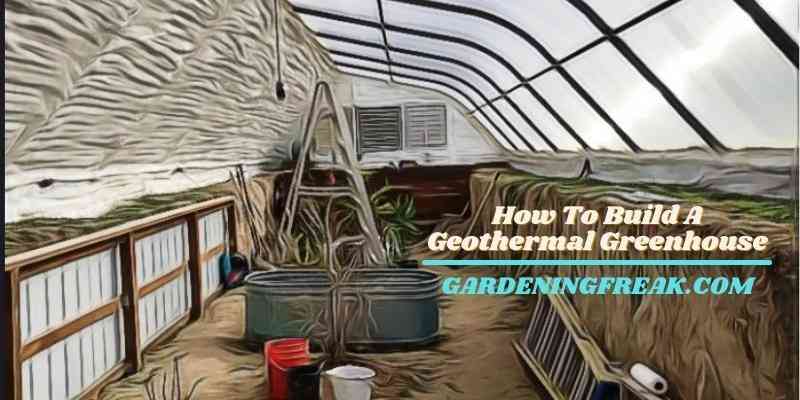Water and soil under our garden and backyard area have a massive amount of thermal energy. This energy can easily convert into heat. This heat can be utilized to maintain the day and nighttime temperature fluctuation within a greenhouse .Also, it allows usto maintain a healthy humidity level throughout the whole year inside agreenhouses .The best part is geothermal system provides a consistent earth temperature to heat and cool the greenhouse. Moreover, this system is very must cost effective and eco friendly. Here, we will guide you on how to build a geothermal greenhouse step-by-step and how to use this system to get the best value from it. Let’s dive in!
How To Build A Geothermal Greenhouse: Step-by-step
Before creating a geothermal greenhouse, you should first decide whether to use it for residential or commercial purposes. Since most of us want to use them for residentialpurposes, we will talk about themonly.Residential greenhouses require less heating and cooling than a large commercial greenhouse. They usually have smaller diameter pipes, smaller fans and are typically consist of two layers of pipe.The entire Geothermal Greenhouse setup process consist for four steps
- Creating the Insulation System
- Setting Up the Fans Position
- Connecting All the Pipes
- Setting Up the Thermostats
Step 1: Creating the Insulation System
Some people may take the insulation as the pipe component. Insulation is mainly located surrounding the gas system.It is important to insulate around this thermal battery so that heat doesn’t escape during the day or night. There are two applications that you can commonly use with insulation.

Most people use two-inch-thick polyester rigid board insulation pieces during normal excavation. Alternatively, if you prefer to dig out a hole for a greenhouse, you need to line the foundation with the board
Step 2 : Connecting All the Pipes
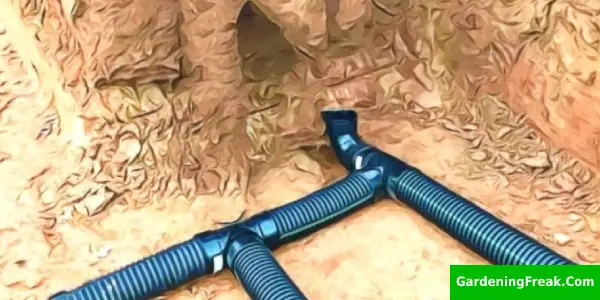
When building Geothermal Greenhouse for residential purposes, you need a 6-inch underground pipe and a 4-inch feeder pipe on the left side. Also, you need to install splitters that will go from the manifold into the four-inch pipe connectors that are perforated and sleeved.Inaddition, you will need a 6″×4″ Reducer and a 6″ connector on the right side.Make sure the two assembled gas systems are assembled properly. One of these will go at four feet below grade, and the other one will go at two feet below grade.This pipeline is a nonperforated pipe since it is connected to the above-ground, and it will go from underground to above-ground. Since there is no elbow-type connection, you can bend it up, allowing you to reuse ends for the system. It helps airflow better.
Step3 : Setting Up the Fans Position
Undoubtedly, the pipes of a geothermal greenhouse are super important because that is where the air has direct contact with the earth and where all the heat exchange takes place.Fans, however, drive that heat exchange because it’s pulling air down into the soil and dictating the power of the GAHT (ground-to-air heat) system.You need to use 6-inch inline fans for your residential system. These fans are rated at 530 CFM, and their actual CFM tends to be slightly lower due to resistance within the pipe.
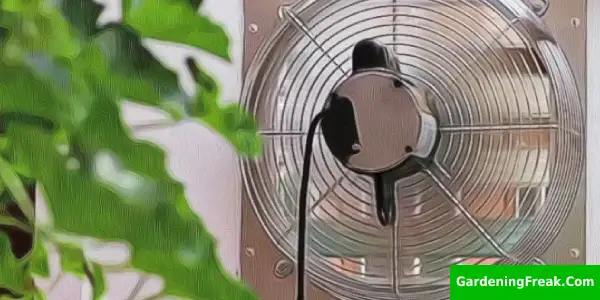
You will install the pipe below ground with PVC on the left side that is connected to the fan. They should be out of the head knocker area. These fans are often called mount fans lower as well. But their installation instruction mainly depends on the design of the greenhouse.It is a good rule of thumb to install the GAHT fan a little bit upper in the greenhouse because that’s where the hottest air is going to reside. In case of an inline greenhouse fan purchase, you can check the below link (#Ads)

Step 4 : Setting Up the Thermostats
The entire GAHTsystems require two thermostats. One for heating and the other one for cooling. You will set up the heating thermostat at 50 degrees Fahrenheit, and the cooler one is at 75 degrees Fahrenheit.

However, you will need another thermostat, which is not a part of the GAHTsystems. But everything is hardwired together.The third one you will use for controlling the exhaust fan .The GAHT cooling thermostats activate a fan when indoor temperatures cross a high threshold but such as 75 degrees Fahrenheit. This temperature can be adjusted due to the specific requirements of your green notes.The gap will turn off when the greenhouse temperature falls between 75 and 50 degrees and then will turn back on to heat when the thermostat drops below the threshold. In this case, 50 degrees go back really quick.
What Is Geothermal Heating
Geothermal heating is known as a ground-to-air heat transfer system. This is also referred to as a GAHT system. This GAHT system allows a greenhouse to provide its heating and cooling throughout the year with only the use of a few small fans. Generally, the soil of underground stores thermal energy, and that’s the way the GAHT system function. A large amount of heat is stored throughout the day from the sunlight. A normal greenhouse will perform the entire task to remove all this heat from the internal area to the outside area. But in the geothermal process lot of excessive heat is stored underground in the soil, which will enter the greenhouse through the GAHT system. If any cool air is needed for the greenhouse, the hot air inside the greenhouse will get outside via pipes buried under the soil.
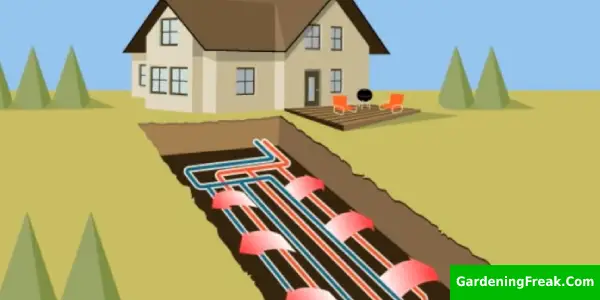
The perimeter of the foundation surrounding the gap system is highly insulated. Meaning that we can increase the soil’s temperatures in the summer/fall. If any warm air is necessary during the colder night, its efficient fan will move the cool air from the greenhouse while adding warm air from the underground soil. To make this easy-going system smooth, you will need a few piping and fans. Those pipe will be installed from the greenhouse to the underneath of the soil.
How Do You Use Geothermal Heat for a Greenhouse
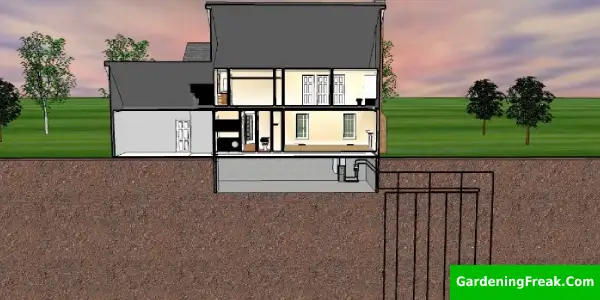
In order to make an effective GAHT system, earth tubes are used under the soil. It can be anywhere between 6 inches to 12 inches.Geothermal heat inside the greenhose can be use in two ways. They are as follow…
Heating the air inside the greenhouse
The soil plays a key role in providing hot air inside the greenhouse space. Compared to surrounding air, the air under the soil is warmer.The corrugated plastic tubes effectively generate air to gather heat during the colder days from that soil and heat the air into the space when required.
Cool the air in greenhose when required
You can use the same geothermal system to cool greenhose space. Generally, the buried tubes will extract the heated air from the greenhouse and replace it with cooler air using the cooler earth.The maximum hot or cool temperature will be equal to soil temperature. So, the more or less the soil temperature, the more or less will be the greenhouse temperature.
However, you can plant ornamentals or bedding plants to increase the temperature by at least 15°-20°F more. If you want, you can also utilize an air heat pump to get warmer air inside the greenhouse.
How Much Does It Cost To Build a Geothermal Greenhouse
Normally, the cost of Geothermal Greenhouse can be calculated per square foot. According to several experts, per square foot cost be anywhere between $6 and $12 per square foot.
Regardless of the DIY project, you are working on, it is necessary first to do a proper calculation so that you can suit your budget. Here are some important numeric numbers you should check out:
- GAHT storage capacity with 1 fan about 400 CFM: 23 million BTU/year
- Cost to run fan: $30/yr
- Electrical Power Saving: $944
- Cost of the GAHT system—2 fan system—(DIY): $2000
Detail explanation of the above numeric numbers
For a residential system, with one fan rated at 530 CFM’s you will get actual CFM somewhere around 400 depending on your elevation and the system design. It can contribute about 23 million BTUs a year to the soil. In one of those fans of years, the costs are$30, and that’s a savings of about, you know, $900 off your electric power bill.Since each fan consists of 2 fan systems, the number will be approximately$1,800. Additionally, you need also to include the materials cost, insulation cost, and the cost of excavation. So, the total cost of 2/3 year payoff periods will be around $2000.
How many pipes Do We Need For Geothermal Greenhouse
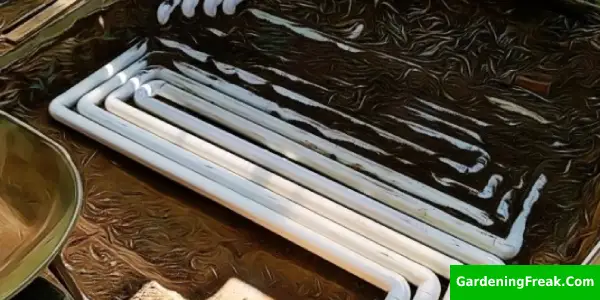
You will need around 500-600 feet of pipefor every ton of the system capacity. For example, if your space size is approximately 2400 square-foot, it will have a four-ton system. So, you will need around 2000-2400 feet of pipe for the entire system capacity.
However, you can measure it of your own to become 100% sure about how much pipe do you need for Geothermal Greenhouse. Bury a few septic tubing under the soil, and they should reach at least several feet for better measurement. It will help you measure each square foot of space being heated/ cooled.
Useful Geothermal Greenhouse Kits
You will need various types of kits to setup a Geothermal Greenhouse. Here is the list of things you will need to create a DIY Geothermal Greenhouse and also provide a probable cost list…
| Items | Price |
| Greenhouse Plastic | $200-$220 |
| Drain Pipe | $300-$400 |
| Wiggle Wire | $400-$450 |
| Adhesive Tape | $50-$60 |
| Potting Benches | $100-$120 |
| Trencher | $100-$120 |
| Lumber | $400-$450 |
| Mini Excavator | $400-$450 |
There are other kits you may prefer to use based on your requirements. For example, you can use Rolled rubber or Interlocking tiles for flooring. You will have to spend around $2 per square foot for Rolled rubber flooring, while a box of Interlocking will cost about $170. Below we provide a side from where you can check all the necessaty greenhouse kits . (#Ads).

You can use different things for siding, such as glass, Polyethylene, Fiberglass, Polycarbonate, etc. Each will have a different cost. For instance, the price of Polycarbonate siding per square foot is high, which can be around $59 per square foot. If you prefer an affordable option, you choose the Polyethylene siding, which could be approximately $.12 per square foot.
Things to remember before installing the geothermal system inside greenhouse
Here are important tips you should remember while setting up a geothermal greenhouse on your own:
Size of the fan
Please make sure the GAHT system fans are not too big or too small; their size should be perfect.
Diameter of the tubing
Ensure the Greenhouse tubing diameter is ideal in size, neither too small nor too big.
Check the pipe sealing
Ensuring proper pipe sealing is important to prevent any unwanted air leakage.
Careful about mold problem
Properly setup the GAHT pipes to ensure perfect perforation of the underground pipes; this will prevent mold issues.
Protection for pipe
You should use a thin layer of cloth for the drain pipe and chicken wire for the exhaust pipes to prevent blockage issues.
FAQs
How Warm Does A Greenhouse Get?
It depends on the temperature gradient inside the greenhouse on the ground, controlled by the climate.So, the external environment will heavily impact how warm or cool your geothermal greenhouse becomes. Generally, you can retain around 30 degrees Fahrenheit warmer than the air outside the environment.Other variables can be the fan power and itssize and the shape of your greenhouse. In addition, the thermostat is greatly affected by the sunlight.
What Is Low-Grade Geothermal (LGG)?
Two types of energy are mainly associated with low-grade geothermal (LGG): store energy and dispense energy. The stored energy will cycle warm air to remove cold air from the greenhouse, while the dispensed energy will cycle cold air to remove cool air from the greenhouse.
How Deep Does A Geothermal Greenhouse Need To Be?
In the majority of our systems, we bury it four feet. Residential will have a layer at two and four feet. But for the commercial greenhouse, it can be as deep as 12 feet where we can really get that consistent temperature of the earthHowever, many experts found that due to typical foundation depths for greenhouses and the economy of excavation, four feet is a sufficient level of soil temperatures. However, it may vary based on your location, and it may not be adequate by high-performing soil temperatures.
How Is Geothermal Energy Transferred?
Generally, the geothermal system uses a converting appliance to transfer energy between spaces. Another name is the ground source heat pump. The antifreeze solution or circulating water plays a key role in collecting energy from the ground and transferring it via loops of tubs. A particular depth is followed to lay out in trenches, which is finally handled by the soil.After coming into the ground, the GAHT system will consistently maintain a stable and favorable temperature with the help of the fluid in the loops. It is generally approximately 50 degrees. The temperature won't change regardless of how cold or hot the environment is.
Conclusion
Geothermal is one of the finest environment-friendly greenhouse systems you can use for residential or commercial purposes. Though the installation cost is slightly higher, you will enjoy minimal costs for electricity to operate the system once you set up everything.Apart from that, most of the time, you can setup it up on your own. This content is just a helping hand to installed a geothermal greenhouse for you. Hopefully, this article has helped you learn how to build a geothermal greenhouse and how much cost you need to bear based on the materials you want to use.

